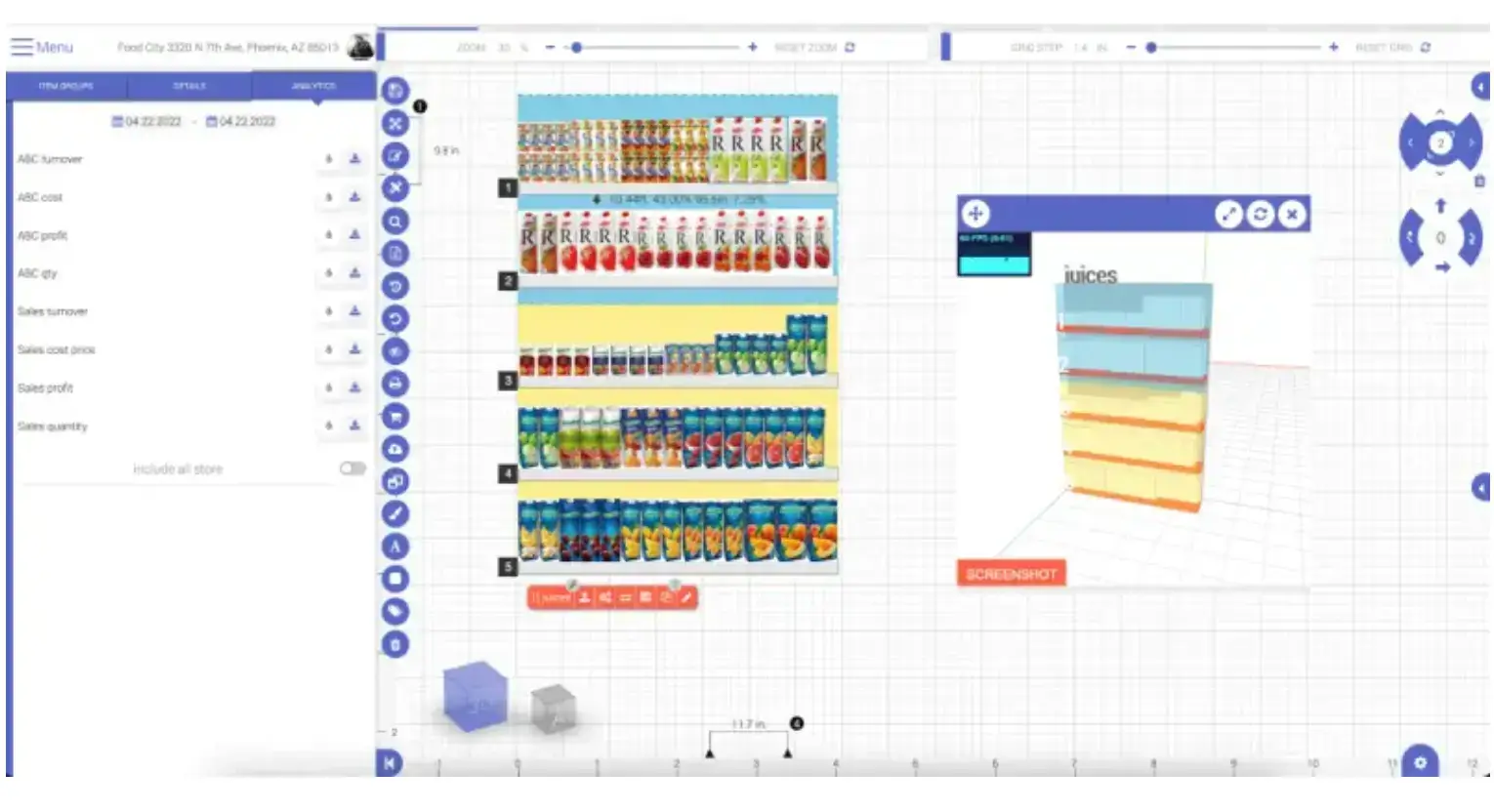A planogram, which is a visual representation of a retail space, is crucial for optimizing product placement in retail settings.
Planograms are essential in retail as they help retailers optimize their store layout and product displays. By using planograms, retailers can ensure that their products are displayed in the best way to encourage customers to buy more.
What is a Planogram, and Why is it Important in Retail?
A planogram is a tool used in retail stores to optimize product placement and increase sales. It strategically positions merchandise to maximize sales, improve customer experience, and ensure efficient use of shelf space.
Why is it important?
- Enhanced Product Visibility:
- Planograms ensure that high-demand and popular products are prominently displayed, increasing their chances of being seen and purchased.
- You use planogramming in merchandising, while a planogram specialist will analyze sales patterns to recommend product facings.
- Improved Customer Experience:
- A well-designed planogram can make it easier for customers to find the products they need, reducing frustration and encouraging them to stay longer in the store.
- Moreover, planogram software also helps retailers save time and money by reducing the need for manual labor in product placement and reducing the amount of wasted space.
- Increased Sales:
- By strategically placing products, planograms can drive impulse purchases and cross-selling, leading to higher sales revenue.
- Efficient Inventory Management:
- Planograms help retailers maintain optimal stock levels, preventing stockouts and overstocking, which can both impact sales.
- Consistent Brand Experience:
- For retailers with multiple locations, planograms can ensure a consistent and recognizable store layout across all stores, strengthening brand identity.
- Data-Driven Decision Making:
- Planograms provide valuable data on product performance, allowing retailers to make informed decisions about product assortment, pricing, and promotions.

A planogram example in a grocery store
Examples of Planograms & the Goals They Help Accomplish
Planograms play a critical role in the retail industry by enabling retailers to optimize their store layout and product displays, enhancing the overall shopping experience, increasing sales, and improving inventory management.
-
Macrospace Planograms
Determine the comprehensive store layout by strategically placing departments, aisles, and categories to maximize customer flow and create an immersive shopping environment.
By carefully considering customer behavior and preferences, Macrospace planograms ensure that the store layout facilitates easy navigation and a seamless shopping experience.

An example of a macro space planogram
-
Category Planograms
These are other essential components of effective retail management. They focus on organizing and displaying products within specific categories, aiding retailers in showcasing their merchandise, introducing new items, and maintaining optimal inventory levels.

These planograms enable retailers to streamline product placement, make it convenient for customers to locate desired items, and aid in effective inventory management practices.
-
Seasonal Planograms
These have specific designs to promote products related to seasonal events or holidays.
Retailers utilize these planograms to highlight seasonal merchandise, align their offerings with the current season or event, and create visually appealing displays that capture customers' attention.
With the flexibility to adapt to changing seasons and events, Seasonal Planograms enable retailers to effectively leverage shopping preferences and demands associated with different times of the year.
-
Promotional Planograms
They are a powerful tool for retailers to promote specific products or brands. These planograms have particular designs to increase sales by strategically showcasing promotions, discounts, and other marketing strategies.
By featuring products in high-visibility areas and leveraging eye-catching displays, Promotional Planograms entice customers to make impulse purchases and engage in cross-selling, thereby driving revenue growth.
Retailers can utilize planograms to improve inventory management practices, ensuring proper stock levels and minimizing overstocking or understocking issues.
Additionally, planograms streamline store operations, reducing restocking and product organization time and ultimately enhancing operational efficiency and cost-effectiveness.
Moreover, planograms significantly enhance the overall customer experience. By arranging products logically and intuitively, planograms make it easier for customers to find what they want, ultimately improving customer satisfaction and loyalty.
Additionally, planograms can position complementary products, encouraging cross-selling and increasing the average transaction value.
One of the critical advantages of planograms is their ability to help retailers adapt swiftly to changes in consumer trends and preferences.
By regularly updating planograms to reflect current market conditions, retailers can respond effectively to shifts in customer demand, ensuring their product offerings remain aligned with evolving trends.
This responsiveness to consumer preferences enables retailers to maintain a competitive edge in the market and cater to changing customer expectations.

Advantages of Using Planogram Software
Retailers can simplify their retail planning process by utilizing planogram software. This software uses data related to sales and space to create customized planograms that consider a store's unique layout, sales, and logistics requirements.
The software supports various fixtures and offers visualization tools and performance data to simplify decision-making.
One of the major benefits is the software's paperless approach, which enables the creation of appealing and profitable planograms with minimal manual input.
Additionally, the software provides updated reports, monitoring, and analytics, allowing for efficient merchandising and optimization of business operations.
With planogram analytics software, retailers can analyze and optimize layouts using indicators such as ABC, available areas, and sales per square foot/meter. It helps save time and labor costs while maximizing sales per unit of space.
Benefits of Using Planograms in Retail
Planograms offer numerous advantages for retail businesses of all sizes. Here are some key benefits:
- Increased Sales:
-
- Strategic Placement: Planograms ensure that high-demand products are prominently displayed in high-traffic areas, maximizing visibility and impulse purchases.
- Cross-Merchandising: By strategically placing complementary products together, planograms can encourage customers to add more items to their carts, boosting sales.
- Seasonal Promotions: Planograms allow retailers to effectively showcase seasonal products and promotions, driving sales during specific periods.
- Improved Customer Experience:
-
- Enhanced Navigation: Well-executed planograms make it easier for customers to find the products they need, reducing frustration and improving the overall shopping experience.
- Visually Appealing Displays: Planograms can create visually appealing and organized store layouts that attract customers and encourage them to stay longer.
- Personalized Recommendations: By analyzing customer data, retailers can use planograms to personalize product recommendations and create targeted displays.
- Optimized Inventory Management:
-
- Reduced Stockouts: Planograms help ensure that products are consistently available by identifying optimal stock levels for each SKU based on sales data.
- Minimized Overstock: By preventing overstocking, planograms help reduce inventory costs and avoid markdowns.
- Improved Replenishment: Planograms provide clear guidelines for store associates, streamlining the replenishment process and reducing labor costs.
- Increased Operational Efficiency:
-
- Standardized Layouts: Planograms create consistent store layouts across multiple locations, simplifying training and ensuring a consistent brand experience.
- Improved Space Utilization: By optimizing shelf space, planograms help retailers maximize the revenue potential of their stores.
- Data-Driven Decision Making: Planograms provide valuable data on product performance, enabling retailers to make informed decisions about product assortment and pricing.
Example:
A grocery store might use a planogram to place popular breakfast cereals at eye level, while placing less popular brands on lower shelves. This strategy can increase sales of the popular brands while still providing customers with a variety of choices. Additionally, the planogram might place milk and bread near the entrance of the store to capture impulse purchases.
FAQ
1. What is a planogram?
A planogram is a visual representation that shows how products should be displayed on shelves in retail stores to maximize sales.
2. Why are planograms important in retail?
Planograms help retailers optimize product placement, increase visibility, and enhance customer experience, ultimately leading to higher sales.
3. What types of planograms are used in retail?
Retailers typically use macrospace, category, seasonal, and promotional planograms to organize their merchandise effectively.
4. How can planogram software benefit retailers?
Planogram software simplifies the creation of layouts, helps manage inventory efficiently, and provides analytics to optimize store performance.
5. How often should planograms be updated?
Planograms should be updated regularly to reflect seasonal changes, sales trends, and shifts in consumer preferences to maintain effectiveness.
6. What are the common challenges in implementing planograms?
Common challenges include ensuring compliance among staff, adapting to inventory changes, and maintaining customer flow in-store.
Conclusion
In conclusion, understanding what is a planogram and effectively utilizing them is crucial for retail success. It's just one of the many small business productivity tips you can find on the POWR blog.
A retail planogram is a strategic tool that optimizes product placement, enhances customer experience, and boosts sales.
By implementing effective planograms, retailers can ensure that their products are displayed most effectively, enticing customers to purchase and significantly increasing profitability.


